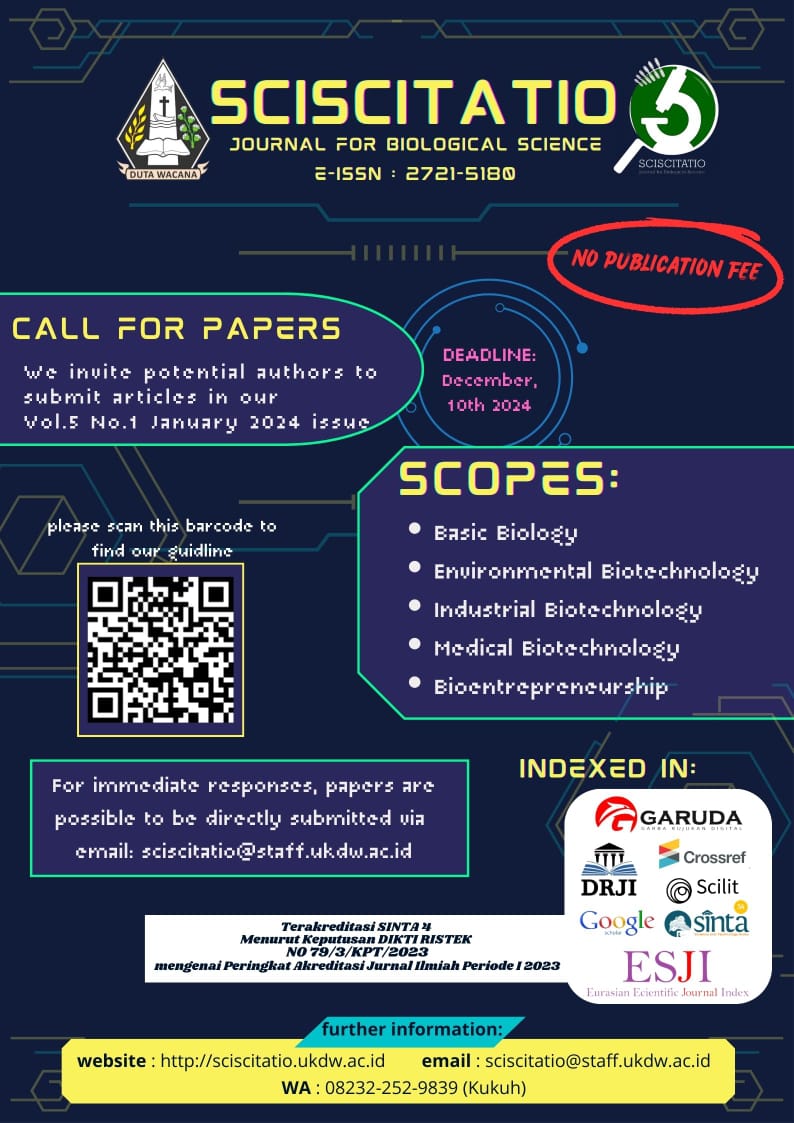Community Perception Surrounding Riung National Park to the Conservation of Komodo Dragon
DOI:
https://doi.org/10.21460/sciscitatio.2020.12.29Keywords:
community perception, fire, Komodo, savannaAbstract
People on Benteng Tengah, Nangamese and Latung have been living in Flores Island and smaller island nearby Flores, like Ontoloe, long before the establishment of national park. In 1992 and 1996, the government established Nature Conservation of Wolo Tado, Nature Conservation of Riung and Marine Nature Conservation of 17 Pulau. This decision led to government’s policy to prohibit the opening of land by burning. Local people used to open a land for agricultural purpose by setting a fire in order to regenerate the savanna to promoting the growth of young grass leaves. People use young grass to feed their cattle. This prohibition causes the people had to herd their cattle far from they live. As the consequence, threat from Komodo (Varanus komodoensis) to attack cattle is increased and people consider Komodo as pest that has to be terminated. This research aimed to study people’s knowledge about Komodo status as endangered species and its implication. Data were collected from people who lives in Benteng Tengah, Nangamese, and Latung, Regency of Ngada, East Nusa Tenggara. Data were obtained from respondents using interviews and questionnaires. Perception of local people who lives in Benteng Tengah (93%), Nangamese (93%) and Latung (100%) showed that people are aware about Komodo’s habitat vegetation. Good perception on Komodo and habitat vegetation will maintain komodo sustainability.
References
Bekele, A & T. Kumssa. (2014). Attitude and Perceptions of Local Resident toward the Protected Area of Abija-Shalla Lakes National Park (ASLNP), Ethiopia. Ecosystem and Ecography, 1(4), 1-5.
Bitanyi, S. M., Nesje, L. J. M., Kusiluka, S. W. Chenyambuga., & B. P. Kaltenborn. (2012). Awareness and perception of local people about wildlife hunting in western Serengiti communities. Tropical Conservation Science, 2(5), 208-224.
Ciofi, C., & M. E. de Boer. (2004). Distribution and Conservation of the Komodo Monitor (Varanus komodoensis). Herpetological, 14, 99 – 107.
Gan, J., A. Jarret, & C. J. Gaither. (2015). Landowner response to wildlife risk: Adaptation, mitigation or doing
nothing. Journal of Environmental Management, 159, 186 – 191.
Gandiwa, E. (2012). Local knowledge and perception of animal population abundances by communities adjacent
to the northern Gonarezhou National Park, Zimbabwe. Tropical Conservation Science, 3(5), 255-269.
Gandiwa, E., I. M. A. Heitkönig., A. M. Lokhorst., H. H. T. Prins., & C. Leeuwis. (2013). CAMPFIRE and HumanWildlife Conflict in Local Communities Bordering Northern Gonarezhou National Park, Zimbabwe. Ecology dan Society, 18(4), 7-22.
Ginantra, K., S. Putra, W. Suarna., & W. Kasa. (2014). Botanical Composition of forage by Timor Deer (Cervus timorensis Blainville) in A Monsoon Forest and Savanna of West Bali National Park. International Journal of Pure & Applied Bioscience, 2(5), 205-213.
Graham, K., A. P. Beckerman., & S. Thirgood. (2005). Human-predator-prey conflicts: ecological correlates, prey losses, and patterns of management. Biological Conservation, 122, 159-171.
Inskip, C., Z. Fahad, R. Tully, T. Roberts., & D. MacMillan. (2014). Understanding carnivore killing behavior: Exploring the motivations for killing the tiger in the Sundarbans, Bangladesh. Biological Conservation, 180, 42-50.
Jessop, T.S., T. Madsen., J. Sumner., H. Rudiharto., J.A. Philips., & C. Ciofi. (2006). Maximum body size among insular Komodo dragon populations covaries with large prey density. OIKOS, 112, 422 – 429.
Kull, C.A & P. Laris. (2009). Fire ecology and fire politics in Mali and Madagaskar. Springer, 7, 171-226.
Lamarque, F., J. Anderson., R. Fergusson., M. Lagrange., Y. Osei-Owusu, & L. Baker. (2009). Human-wildlife conflict in Africa: Causes, consequences, and management strategies. Roma. Food and Agriculture Organization of the United Nations.
Li, J., H. Yin., D. Wang., Z. Jiagong, & Z. Lu. (2013). Human-snow leopard conflict in the Sanjiangyuan Region
on the Tibetann Plateau. Biological Conservation, 166, 116-123.
Meena, V., D. W. Macdonald., & R. A. Montgomery. (2014). Managing success: Asiatic lion conservation, interface problems and peoples’ perception in the Gir Protected Area. Biological Conservation, 174, 120-126.
Miranda, H. S., M. N. Sato., W. N. Neto., & F. S. Aires. (2009). Fires in the cerrado, the Brazilian savanna. Springer, 15, 427-450.
Mojo, D., J. Rothschuh., & M. Alebachew. (2014). Farmers’ perception of the impacts of human-wildlife conflict on
their livelihood and natural resource management efforts in Cheha Woreda of Guraghe Zone, Ethiopia. HumanWildlife Interaction, 8(1), 67-77.
Nasution, Z. (2009). Solidaritas Sosial dan Partisipasi Masyarakat Desa Transisi: Suatu Tinjauan Sosiologis. Malang. UMM Press.
Ngakan, P. O., H. Komarudin., A. Achmad., W a h y u d i . , & A . T a k o . ( 2 0 0 6 ) . Ketergantungan, Persepsi dan Partisipasi Masyarakat terhadap Sumberdaya Hayati Hutan, Studi Kasus di Dusun Pampli Kabupaten Luwu Utara, Sulawesi Selatan. Jakarta: Centre for International Forestry Research.
Notoadmodjo, S. (2007). Promosi Kesehatan dan Ilmu Perilaku. Jakarta: Penerbit PT Rineke Cipta.
O’Higgins, R. C. (2007). Savanna Woodland Degradation Assessment in Ghana: integrating ecological indicators with local perceptions. Earth & Environment, 3, 246-281.
Pearce, D. W & R. K. Turner. (1990). Economics of Natural Resources and the Environment. Hertfordshire: Harvester Wheatsheaf.
Ritohardoyo, Su. (2005). Pengelolaan dan Pemetaan Potensi Hutan Mangrove di Pesisir Utara Pulau Sumbawa. Laporan Penelitian. Yogyakarta: Fakultas Geografi UGM.
Sanjay, G. (2012). Patterns and correlates of human-elephant conflict around a south Indian reserve. Biological Conservation, 148, 88-95.
Sarwono, S.W & Eko A. Meinarno. (2011). Psikologi Sosial. Jakarta: Penerbit Salemba Humanika.
Vigilante, T., B. P. Murphy., & D. M. J.
S. Bowman. (2009). Aboriginal fire use in Australian tropical savannas: Ecological effects and management lesson. Springer, 6, 143-167.
Wahyuni, N. I & R. Mamonto. (2012). Persepsi Masyarakat terhadap Taman Nasional dan Sumberdaya Hutan: Studi Kasus Blok Aketawaje, Taman Nasional Aketawaje Lolobata. Info BPK Manado, 2(1), 1-16.
Walgito, B., (2009). Psikologi Sosial: Suatu Pengantar. Yogyakarta: Penerbit ANDI.


